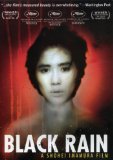| Reviews & Columns |
|
Reviews DVD TV on DVD Blu-ray 4K UHD International DVDs In Theaters Reviews by Studio Video Games Features Collector Series DVDs Easter Egg Database Interviews DVD Talk Radio Feature Articles Columns Anime Talk DVD Savant Horror DVDs The M.O.D. Squad Art House HD Talk Silent DVD
|
DVD Talk Forum |
|
|
| Resources |
|
DVD Price Search Customer Service #'s RCE Info Links |
|
Columns
|
|
|
Black Rain (AnimEigo Release)
AnimEigo // Unrated // October 20, 2009
List Price: $24.98 [Buy now and save at Amazon]
The Film:
Black Rain (Kuroi Ame), Shohei Imamura's potent film about the World War II bombing in Hiroshima, delivers one of the strongest narratives that I've encountered in foreign cinema. This intricate masterwork does innumerable things correctly where other war films go awry. Instead of slapping on too much material and lambasting the viewer with ridiculous levels of military stratagems, Imamura's piece instead concentrates on afterthoughts and character reverberations through an acute visual style. Outside of the condemnation of military strife, this film serves more as a portrait of the time period instead of a message-based delivery. However, Black Rain does take on a theme revolving around the effects of human inflicted devastation, and the willpower it takes to combat succumbing to hardship.
Based on the novel of the same name by Ibuse Masuji, Imamura's film is an illustrative work that focuses heavily on the physical effects of the atomic bombing in Hiroshima -- notably on the Shizuma family and their niece, Yasuko (Yoshiko Tanaka). If the initial blast didn't claim a citizen's life, then the genetic mutation following the blast would scourge the exposed more often than not. This harrowing act and its wave of effects isn't something easy to catch on film, but Black Rain captures the moments directly after the blast that can barely be imagined -- something that we wish we never had once we've seen the possibility -- in frightening, wholly believably ways. Of course, this film stringently presses exceedingly strong anti-war messages once the effects become clear as day; however, it's the themes that walk side by side with these messages that give the viewer added strength.
Black Rain can be looked at predominately as a dramatic insight into humanity's capacity to cope with such a past, as well as a dissection of how they suppress both physical and emotional repercussions from the attack. However, it's also effective as a disturbing physical film displaying the direct horrors of atomic warfare. When a younger boy stumbles up to his elder brother with skin dripping from his bones, chills trail up and down your own skin at the thought -- and at the dramatic implications. It's not just the unsettling vision of his body, but also the evocation felt for the normal child swallowed whole by this menace. Imamura doesn't just show this to invoke fear or grotesqueness within the viewer; he thrusts this boy, as well as an implausible number of other bodies, in hindsight to illustrate the extreme effects of the atomic explosion, effects that would be mildly infused into each and every victim.
But the viewer doesn't see these "victims" in the town during the focal time frame five years later. Instead, Black Rain displays humanistic characters trying with all their might to endure amid the travesty through a tainted existence that's ready to erupt at any moment. That central conflict is one of the core themes within this film, a sense of fuming humanity mixed with the life-crippling black substance fallen from the sky on that day. Certainly, standard war and military messages leak though, as clearly stated in a translated line from the film reflecting the statement that "war is bad", but the alternative strong themes lie in human perseverance. This willpower fluctuates between each individual character, determined directly by the effect suffered from the bomb, and oftentimes alters their perception of the people around them.
For some, such as Yasuko and her aunt and uncle, they strive to achieve a life filled with as much normalcy as possible. Yasuko works to find a husband, all the while deeply vexed by the possibility of her body giving way to the imminent sickness she's taken on from the splattering of "Black Rain". Her plague, though only a potential threat at the time, fleshes out to be a deterrent during her engagement problems, but she doesn't let this completely affect her demeanor. Yoshiko Tanaka delivers a masterful performance, brimming with subdued yet struggling effervescence as she fights to find a place within her changed world. The Shizumas, also exposed to this epidemic during the explosion, purely fight to stay afloat and healthy during their strife. Health and Yasuko are their only real concerns, shown by their tear-worthy drives to outline her after-bombing existence through searching for a husband -- and resiliently insisting that she's not a direct bomb victim.
Others, however, have to deal with the mental distortion that the bomb created. Yuichi, an ex-soldier turned psychotic "road protector" who carves stone gargoyles of frightened faces, clearly lost something during the explosion, as did many others to varying degrees. Mental strife, however, doesn't just come in the form of insanity; waning morale also torments many of the townsfolk. It's clearly shown through a set of fisherman, even those without effort hold a hopeless demeanor that prevents them from trying to harness life's potential. As stated in the film, "men with narrow minds think things and imagine others". The psychological status of the survivors, both as a hive-mind and as individuals, provides the most compelling elements in Black Rain, showcasing their deconstruction following an American act seen as a brutal yet necessary war-shortening decision.
If anything is to be learned from Imamura's haunting portrait, it's that humanity holds the capacities to stomach passed the atrocities of life, war, and conflict and try ardently to force through these hardships. That is, if they muster the power to do so. Black Rain reminds that everyone is a victim that's involved in a crisis, whether physically assailed or mentally afflicted. But if they press forward and care for themselves, then they'll live out as strong of an existence as possible. Certainly, war is a horrible thing; however, no matter how ominous the effects, humanity can still salvage life amidst the corruption. Black Rain gives the viewer a devastatingly beautiful anti-war vision, but it also gives off a message of willpower delivered through a very tough narrative.
The DVD:
Video and Audio:
Desperately in need of a new presentation for quite some time now, AnimEigo takes the call to action in presenting Black Rain in a proper fashion befitting the film's strength. Its ~1.75:1 anamorphic widescreen transfer has been windowboxed (a black frame appears around the image) and leans a slight amount to the tan side instead of true black and white within quite a few sequence, yet its leaps-and-bounds improvement over the long out-of-print -- and unattractively offered -- Image Entertainment DVD is overwhelmingly noticeable.
Black levels and contrast are essential in this grayscale image since Imamura elected to use black and white film stock to convey a poetic message, all of which AnimEigo's transfer communicates in stable, natural fashion -- if on the flat, gray side -- that keeps blooming issues and detail preservation in mind. The photography doesn't focus much on intricate detail, yet it still shows a grasp on textures, clothing design, and environment both in the bomb-rattled Japanese landscape and within interior shots. Black Rain arrives with a clean, considerably superior and stable image, finally doing justice to a picture deserving a fine treatment.
Audio for Black Rain arrives in a Japanese Dolby 2.0 Stereo track that has ups and down, yet stays largely sustainable for the film's purposes. Some instances of dialogue and musical accompaniment push a little hard on the upper shelf of its limitations, distorting a bit as they grow more intense. Other sequences, conversely, maintain a thoroughly involving disposition that showcase an extremely impressive grasp on dialogue breadth and musical accompaniment. It's largely free of any other forms of off-putting popping or distortion (though an extremely light hiss can be picked up in the quietest of sequences), accumulating into a strong match for the visual treatment.
Subtitles:
Removable English subtitles are available, as per AnimEigo's thorough standards, in both white and yellow type that appears in thick face at the lower portion of the image. If two characters speak at the same time, the colors shift to represent two entities -- such as white and gray in the "White" subtitles. They're available in both Dialogue Only and Full Subtitle options, the latter being an explanatory track that also clears up any curiosity about Japanese elements for other cultures unaware of their meaning. All of the dialogue, as with AnimEigo's other classic Japanese cinema releases, pleases with its natural and accurate context.
Special Features:
Interview with Takashi Miike, Black Rain's Assistant Director (8:01, 4x3):
Though the Audition director says he was "more like a dog" on the set of Black Rain, he means that in a very positive way. Takashi Miike recalls his time spent next to Imamura on-set, discussing the presence of five of six "second directors" and how he felt like he was wasting precious time watching others do something else while filming. He also mentioned the enduring impression Imamura placed on him as a film-maker, how he melded him. Probably the most intriguing element discussed is the "battle" between Imamura and writer Ibuse Masuji, as well as the incorporation of the lost color sequence and having to re-shoot the last scene.
Interview with Yoshiko Tanaka (6:38, 4x3):
The lead actress discusses her experience in learning she was working on an adaptation of Ibuse Masuji's book with director Shohei Imamura, as well as her experience with "lodging" together with the other actors. She discusses little things, like not having a convenience store in the 40-some-odd person village where they were filming and about how they accommodated to what she needed during the process. Keep an eye out for the splices of behind-the-scenes shots, which are brief but neat to see.
Multimedia Vault:
Included under this tab are several slates of archival footage from the mid-40s, leading up to and following the bombings at Hiroshima and Nagasaki. Along with a Photographic Historical Journal containing a slate of both American and (graphic) Japanese photos, it includes five vintage television/radio pieces: Our Enemy: The Japanese (1943, 19:52), My Japan (1945, 16:03), A Tale of Two Cities (1946, 12:02), Atom Blast at Hiroshima (1946, 1:18), and the Truman Radio Address (1945, 0:26).
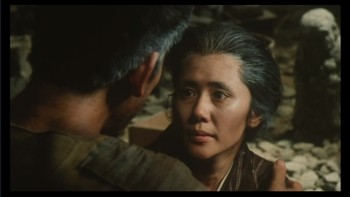 19-Minute Color Alternate Ending (Spoilers Below):
19-Minute Color Alternate Ending (Spoilers Below):
One of the most impacting things about Black Rain lies in its vague albeit tragically assumed finale. However, Imamura also shot an alternate conclusion that answers the question posed at the very end of the film -- in a fashion that goes against the bleak theory behind the film's conclusion. Instead, it follows Yasuko many years later as she comes to grip with her fear of death, all while heading on a final pilgrimage to heighten her life's end. Though it tinkers with the motives at the end of the original film, it does showcase a transformational extension of Yoshiko Tanaka's phenomenal performance.
Also available are AnimEigo's traditionally informative text-based Program Notes, which delve into the connections between real-life events and the dialogue/images that appear in the film itself, a nice Image Gallery, Cast/Crew Bios, and a Trailer (2:35, 4x3 Letterbox).
Final Thoughts:
Shohei Imamura's Black Rain is simply magnificent, in every way imaginable. Along with giving us a terrifying, almost horror-level portrait of the WWII atomic bombing in Hiroshima, he constructs an unmatched, profoundly cerebral analysis on the physiological and psychological effects on everyday citizens coated with the curse of the "black rain". Uncompromising performances arise in the aftermath of the strikingly detailed event, especially with Yoshiko Tanaka's gripping turn as Yasuko, concluding in a bleak yet blisteringly emotional conclusion. Imaura's film itself comes with the highest of regards, yet AnimEigo have come along and done an immensely admirable job with presenting Black Rain in strong cinematic fashion -- just in time for its 20th anniversary. Along with an impressive slate of extras to match the much-improved presentation of a masterful film, this much-awaited release of a significant work in Japanese cinema comes with an exceedingly High Recommendation.
Thomas Spurlin, Staff Reviewer -- DVDTalk Reviews | Personal Blog/Site
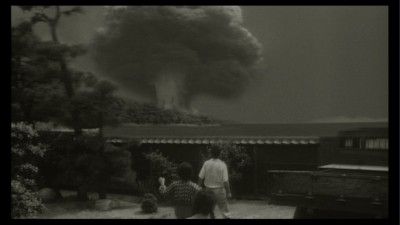 |
Based on the novel of the same name by Ibuse Masuji, Imamura's film is an illustrative work that focuses heavily on the physical effects of the atomic bombing in Hiroshima -- notably on the Shizuma family and their niece, Yasuko (Yoshiko Tanaka). If the initial blast didn't claim a citizen's life, then the genetic mutation following the blast would scourge the exposed more often than not. This harrowing act and its wave of effects isn't something easy to catch on film, but Black Rain captures the moments directly after the blast that can barely be imagined -- something that we wish we never had once we've seen the possibility -- in frightening, wholly believably ways. Of course, this film stringently presses exceedingly strong anti-war messages once the effects become clear as day; however, it's the themes that walk side by side with these messages that give the viewer added strength.
Black Rain can be looked at predominately as a dramatic insight into humanity's capacity to cope with such a past, as well as a dissection of how they suppress both physical and emotional repercussions from the attack. However, it's also effective as a disturbing physical film displaying the direct horrors of atomic warfare. When a younger boy stumbles up to his elder brother with skin dripping from his bones, chills trail up and down your own skin at the thought -- and at the dramatic implications. It's not just the unsettling vision of his body, but also the evocation felt for the normal child swallowed whole by this menace. Imamura doesn't just show this to invoke fear or grotesqueness within the viewer; he thrusts this boy, as well as an implausible number of other bodies, in hindsight to illustrate the extreme effects of the atomic explosion, effects that would be mildly infused into each and every victim.
But the viewer doesn't see these "victims" in the town during the focal time frame five years later. Instead, Black Rain displays humanistic characters trying with all their might to endure amid the travesty through a tainted existence that's ready to erupt at any moment. That central conflict is one of the core themes within this film, a sense of fuming humanity mixed with the life-crippling black substance fallen from the sky on that day. Certainly, standard war and military messages leak though, as clearly stated in a translated line from the film reflecting the statement that "war is bad", but the alternative strong themes lie in human perseverance. This willpower fluctuates between each individual character, determined directly by the effect suffered from the bomb, and oftentimes alters their perception of the people around them.
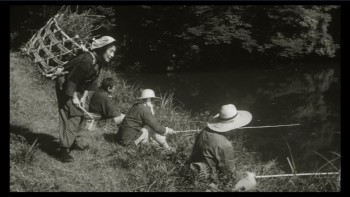 | 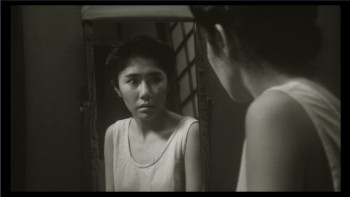 |
For some, such as Yasuko and her aunt and uncle, they strive to achieve a life filled with as much normalcy as possible. Yasuko works to find a husband, all the while deeply vexed by the possibility of her body giving way to the imminent sickness she's taken on from the splattering of "Black Rain". Her plague, though only a potential threat at the time, fleshes out to be a deterrent during her engagement problems, but she doesn't let this completely affect her demeanor. Yoshiko Tanaka delivers a masterful performance, brimming with subdued yet struggling effervescence as she fights to find a place within her changed world. The Shizumas, also exposed to this epidemic during the explosion, purely fight to stay afloat and healthy during their strife. Health and Yasuko are their only real concerns, shown by their tear-worthy drives to outline her after-bombing existence through searching for a husband -- and resiliently insisting that she's not a direct bomb victim.
Others, however, have to deal with the mental distortion that the bomb created. Yuichi, an ex-soldier turned psychotic "road protector" who carves stone gargoyles of frightened faces, clearly lost something during the explosion, as did many others to varying degrees. Mental strife, however, doesn't just come in the form of insanity; waning morale also torments many of the townsfolk. It's clearly shown through a set of fisherman, even those without effort hold a hopeless demeanor that prevents them from trying to harness life's potential. As stated in the film, "men with narrow minds think things and imagine others". The psychological status of the survivors, both as a hive-mind and as individuals, provides the most compelling elements in Black Rain, showcasing their deconstruction following an American act seen as a brutal yet necessary war-shortening decision.
If anything is to be learned from Imamura's haunting portrait, it's that humanity holds the capacities to stomach passed the atrocities of life, war, and conflict and try ardently to force through these hardships. That is, if they muster the power to do so. Black Rain reminds that everyone is a victim that's involved in a crisis, whether physically assailed or mentally afflicted. But if they press forward and care for themselves, then they'll live out as strong of an existence as possible. Certainly, war is a horrible thing; however, no matter how ominous the effects, humanity can still salvage life amidst the corruption. Black Rain gives the viewer a devastatingly beautiful anti-war vision, but it also gives off a message of willpower delivered through a very tough narrative.
The DVD:
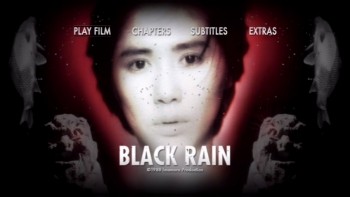 | 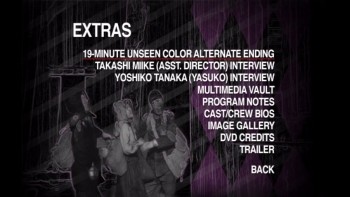 |
Video and Audio:
Desperately in need of a new presentation for quite some time now, AnimEigo takes the call to action in presenting Black Rain in a proper fashion befitting the film's strength. Its ~1.75:1 anamorphic widescreen transfer has been windowboxed (a black frame appears around the image) and leans a slight amount to the tan side instead of true black and white within quite a few sequence, yet its leaps-and-bounds improvement over the long out-of-print -- and unattractively offered -- Image Entertainment DVD is overwhelmingly noticeable.
Black levels and contrast are essential in this grayscale image since Imamura elected to use black and white film stock to convey a poetic message, all of which AnimEigo's transfer communicates in stable, natural fashion -- if on the flat, gray side -- that keeps blooming issues and detail preservation in mind. The photography doesn't focus much on intricate detail, yet it still shows a grasp on textures, clothing design, and environment both in the bomb-rattled Japanese landscape and within interior shots. Black Rain arrives with a clean, considerably superior and stable image, finally doing justice to a picture deserving a fine treatment.
Audio for Black Rain arrives in a Japanese Dolby 2.0 Stereo track that has ups and down, yet stays largely sustainable for the film's purposes. Some instances of dialogue and musical accompaniment push a little hard on the upper shelf of its limitations, distorting a bit as they grow more intense. Other sequences, conversely, maintain a thoroughly involving disposition that showcase an extremely impressive grasp on dialogue breadth and musical accompaniment. It's largely free of any other forms of off-putting popping or distortion (though an extremely light hiss can be picked up in the quietest of sequences), accumulating into a strong match for the visual treatment.
Subtitles:
Removable English subtitles are available, as per AnimEigo's thorough standards, in both white and yellow type that appears in thick face at the lower portion of the image. If two characters speak at the same time, the colors shift to represent two entities -- such as white and gray in the "White" subtitles. They're available in both Dialogue Only and Full Subtitle options, the latter being an explanatory track that also clears up any curiosity about Japanese elements for other cultures unaware of their meaning. All of the dialogue, as with AnimEigo's other classic Japanese cinema releases, pleases with its natural and accurate context.
Special Features:
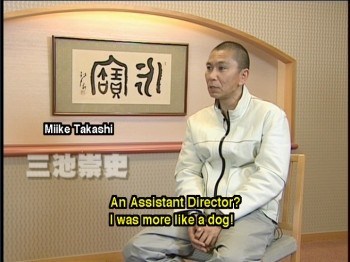 | 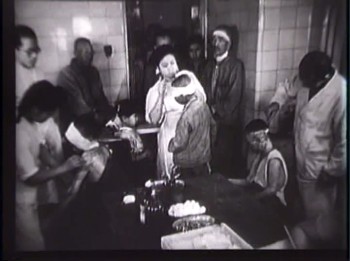 |
Interview with Takashi Miike, Black Rain's Assistant Director (8:01, 4x3):
Though the Audition director says he was "more like a dog" on the set of Black Rain, he means that in a very positive way. Takashi Miike recalls his time spent next to Imamura on-set, discussing the presence of five of six "second directors" and how he felt like he was wasting precious time watching others do something else while filming. He also mentioned the enduring impression Imamura placed on him as a film-maker, how he melded him. Probably the most intriguing element discussed is the "battle" between Imamura and writer Ibuse Masuji, as well as the incorporation of the lost color sequence and having to re-shoot the last scene.
Interview with Yoshiko Tanaka (6:38, 4x3):
The lead actress discusses her experience in learning she was working on an adaptation of Ibuse Masuji's book with director Shohei Imamura, as well as her experience with "lodging" together with the other actors. She discusses little things, like not having a convenience store in the 40-some-odd person village where they were filming and about how they accommodated to what she needed during the process. Keep an eye out for the splices of behind-the-scenes shots, which are brief but neat to see.
Multimedia Vault:
Included under this tab are several slates of archival footage from the mid-40s, leading up to and following the bombings at Hiroshima and Nagasaki. Along with a Photographic Historical Journal containing a slate of both American and (graphic) Japanese photos, it includes five vintage television/radio pieces: Our Enemy: The Japanese (1943, 19:52), My Japan (1945, 16:03), A Tale of Two Cities (1946, 12:02), Atom Blast at Hiroshima (1946, 1:18), and the Truman Radio Address (1945, 0:26).
 19-Minute Color Alternate Ending (Spoilers Below):
19-Minute Color Alternate Ending (Spoilers Below): One of the most impacting things about Black Rain lies in its vague albeit tragically assumed finale. However, Imamura also shot an alternate conclusion that answers the question posed at the very end of the film -- in a fashion that goes against the bleak theory behind the film's conclusion. Instead, it follows Yasuko many years later as she comes to grip with her fear of death, all while heading on a final pilgrimage to heighten her life's end. Though it tinkers with the motives at the end of the original film, it does showcase a transformational extension of Yoshiko Tanaka's phenomenal performance.
Also available are AnimEigo's traditionally informative text-based Program Notes, which delve into the connections between real-life events and the dialogue/images that appear in the film itself, a nice Image Gallery, Cast/Crew Bios, and a Trailer (2:35, 4x3 Letterbox).
Final Thoughts:
Shohei Imamura's Black Rain is simply magnificent, in every way imaginable. Along with giving us a terrifying, almost horror-level portrait of the WWII atomic bombing in Hiroshima, he constructs an unmatched, profoundly cerebral analysis on the physiological and psychological effects on everyday citizens coated with the curse of the "black rain". Uncompromising performances arise in the aftermath of the strikingly detailed event, especially with Yoshiko Tanaka's gripping turn as Yasuko, concluding in a bleak yet blisteringly emotional conclusion. Imaura's film itself comes with the highest of regards, yet AnimEigo have come along and done an immensely admirable job with presenting Black Rain in strong cinematic fashion -- just in time for its 20th anniversary. Along with an impressive slate of extras to match the much-improved presentation of a masterful film, this much-awaited release of a significant work in Japanese cinema comes with an exceedingly High Recommendation.
|
| Popular Reviews |
| Sponsored Links |
|
|
| Sponsored Links |
|
|
| Release List | Reviews | Shop | Newsletter | Forum | DVD Giveaways | Blu-Ray | Advertise |
|
Copyright 2024 DVDTalk.com All Rights Reserved. Legal Info, Privacy Policy, Terms of Use,
Manage Preferences,
Your Privacy Choices | |||||||









